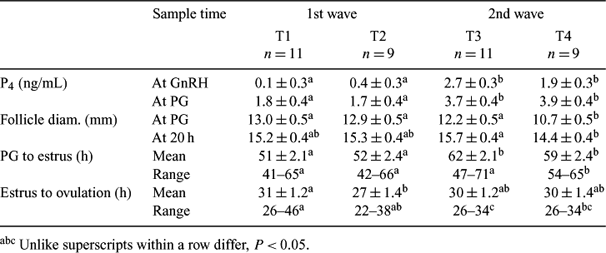208 FOLLICULAR DYNAMICS, ESTRUS, AND OVULATION IN COWS SYNCHRONIZED TO OVULATE FIRST OR SECOND WAVE DOMINANT FOLLICLES USING SHORT- OR LONG-TERM MELENGESTROL ACETATE- OR EAZI-BREED CIDR INSERT-BASED PROTOCOLS
D.J. Schafer A , J.F. Bader A , D.C. Busch A , F.N. Kojima A , M.R. Ellersieck A , M.C. Lucy A , M.F. Smith A and D.J. Patterson AADepartment of Animal Science, University of Missouri, Columbia, MO 65201, USA. Email: djsc04@mizzou.edu
Reproduction, Fertility and Development 17(2) 254-254 https://doi.org/10.1071/RDv17n2Ab208
Submitted: 1 August 2004 Accepted: 1 October 2004 Published: 1 January 2005
Abstract
The objective of this experiment was to determine the feasibility in substituting EAZI-BREED CIDR inserts (CIDR; Pfizer Animal Health, Groton, CT, USA) for melengestrol acetate (MGA) in progestin-based protocols to synchronize estrus in beef cows. Follicular dynamics, timing of estrus, and ovulation were compared in beef cows synchronized to ovulate first or second wave dominant follicles using short- or long-term MGA- or CIDR-based protocols. The study was conducted with 48 nonsuckled, estrous cycling, crossbred beef cows assigned to one of four treatments (T1 to T4; n = 12/T) by age and body condition. Cows were synchronized to ovulate first wave (T1 and T2) or second wave (T3 and T4) dominant follicles based on assignment to treatment. Cows in T1 were fed MGA (0.5 mg h−1 d−1) for 7 days, and were injected with PGF2α (PG; 25 mg Lutalyse; Pharmacia Animal Health, Kalamazoo, MI, USA) on Day 7, GnRH (100 μg Cystorelin; Merial, Athens, GA, USA) on Day 11, and PG on Day 18. Cows in T2 had CIDR (1.38 g progesterone) inserted for 7 days, and were injected with PG on Day 7, GnRH on Day 9, and PG on Day 16. Cows in T3 were fed MGA for 14 days, and were injected with GnRH on Day 26, and PG on Day 33. Cows in T4 had CIDR inserted for 14 days, and were injected the GnRH on Day 23, and PG on Day 30. Transrectal ultrasonography was performed daily to monitor follicular dynamics from GnRH to estrus after PG; and every 4 h from 20 h after the onset of estrus until ovulation. Estrus detection was performed continuously using the HeatWatch® estrus detection system (DDx, Denver, CO, USA). Blood samples for progesterone (P4) were collected daily beginning one day prior to the initiation of treatment and continuing through ovulation following PG. Data were analyzed using the General Linear Models procedure of SAS (SAS Institute, Inc., Cary, NC, USA) and are summarized in the following table. Animals that responded to treatment and were included in the analysis were those that initiated a new follicular wave after administration of GnRH and that displayed estrus within 144 h after PG. Although estrous response was similar among treatments, there were differences in follicular dynamics, steroid secretion patterns, and timing of events that culminated in differences in timing and synchrony of estrus and ovulation among the short- and long-term groups. These differences may be important in relation to fixed-time AI programs. These data suggest that in situations that are not conducive to feeding MGA, substituting CIDR inserts into MGA-based protocols to synchronize estrus may be feasible.

|
This work was supported by USDA-NRI grant 2000-02163; Pfizer Animal Health, New York, NY; and Merial, Athens, GA, USA.


